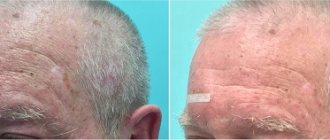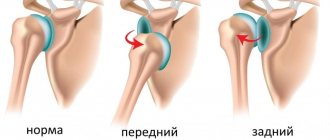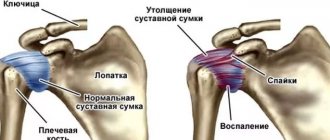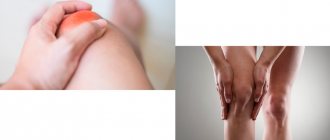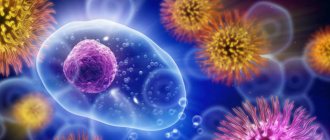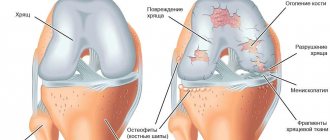Do your joints hurt? There is a risk of developing a disease such as arthralgia.
Arthralgia
– this is a set of painful sensations that arise due to predominantly organic damage to the joints. The presence of pain syndromes can be a harbinger of joint diseases, including the initial stages of arthrosis and arthritis.
Arthralgia is characterized by pain in the joints
Arthralgia syndrome - what is it?
Arthralgia
– these are pain sensations that can occur in one or several joints of the human musculoskeletal system. The disease is secondary and can be observed in diseases of infectious or autoimmune origin, as well as in the presence of excess body weight.
Joint pain is predominantly “volatile” in nature and usually appears unexpectedly and suddenly.
Painful sensations during arthralgia can occur without the influence of external irritating factors, which usually include increased loads and stress.
An attack of pain can last several minutes, or can last up to several hours. Everything is individual and depends solely on the area of progression of organic damage to the joint, as well as the pain threshold and, of course, the general health of the patient.
Often the pain goes away without the use of medications, however, there are cases when the use of analgesics is required.
The manifestation of the syndrome is distinguished according to factors such as:
- location;
- number of lesions;
- intensity and nature of pain;
- duration of pain;
- rhythmicity of discomfort.
Causes of the disease
Traumatologists identify a number of factors that can lead to arthralgia:
- poisoning with salts of heavy metals;
- microtrauma of joints, frequent physical overexertion;
- initial stages of deforming pathologies;
- decreased general immunity;
- long-term therapy with certain medications;
- condition after a severe allergic reaction;
- flat feet;
- rachitic deformities of the lower extremities;
- neuralgia;
- myalgia;
- vascular diseases.
Classification of arthralgia
Key challenge in the treatment of arthralgia
lies in the difficulties of diagnosing it, which is due to the large number of variations in its manifestation and clinical picture.
According to known data, arthralgia is divided into several classifications:
- infectious type
– the occurrence is provoked by general intoxication;
- intermittent
– accompanied by acute and recurrent arthritis;
- long lasting
– characteristic of exceptionally large joints (arthralgia of the knee or hip joint);
- oligo- or polyarthralgia
– the causes are inflammation of the joint, as well as destruction of cartilage tissue;
- post-traumatic
– appears as a residual manifestation of inflammation;
- false
.
It is important to note that each type is accompanied by a certain type of pain.
Why do joints hurt?
Common infectious diseases
Arthralgic syndrome often accompanies the course of acute infections. Joint pain can occur both in the prodromal period of the disease and in the early clinical stage, which occurs with fever and intoxication. The infectious form of arthralgia is characterized by “aches” in the joints of the lower and upper extremities, the polyarticular nature of the pain, and its association with myalgia. Mobility in the joint is completely preserved. Typically, arthralgia of an infectious nature disappears within a few days as the toxic syndrome caused by the underlying disease weakens.
Infectious arthritis
There are possible options for the development of post-infectious reactive arthralgia after acute intestinal or urogenital infections; parainfectious arthralgic syndrome caused by tuberculosis, infective endocarditis, secondary syphilis. Often the cause of joint pain is foci of existing chronic infection - pyelonephritis, cholangitis, adnexitis, peritonsillar abscess or parasitic infestation.
Residual arthralgia after inflammation of the joints is chronic or transient. Pain and stiffness in the joints may persist for weeks or months; subsequently, the health and functions of the limbs are completely restored. In the chronic form of arthralgia, its exacerbations are associated with overexertion, weather lability, and hypothermia.
Rheumatic diseases
Joint pain of the poly- or olo-arthralgia type is the main symptom of inflammatory rheumatic diseases. Rheumatic arthralgia is characterized by constant, intense, migrating pain syndrome, involvement of large joints mainly of the lower extremities, and limited movement in the joints.
The onset of rheumatoid arthritis, as well as systemic rheumatic diseases, are manifested by polyarticular syndrome, involving small symmetrical joints of the feet and hands, and motor stiffness in the morning.
In microcrystalline gouty arthritis, arthralgia manifests itself in the form of recurrent paroxysmal pain in an isolated joint, which, suddenly arising, quickly reaches a peak intensity and does not subside for several days.
Degenerative joint lesions
Joint pain that gradually increases over a long period of time may indicate deforming osteoarthritis and other degenerative-dystrophic lesions. In this case, involvement of the knee or hip joints is typical; dull, aching, exercise-related type of pain and its disappearance with rest. Arthralgia can be weather-dependent, accompanied by “crunching” of the joints during movement, and weakened with the use of local distraction therapy.
Joint injuries
Bruises, dislocations of joints, damage to the ligaments, intra-articular fractures are accompanied by severe pain. The affected joint becomes swollen, deformed, and hot to the touch. The supporting function of the lower limb is impaired, movements in the joint are difficult, and sometimes pathological mobility occurs. Injuries may be accompanied by hemorrhage into the joint cavity, which leads to joint stiffness.
Oncological diseases
Persistent oligo- and polyarthralgia of a long course, accompanied by the formation of “Hippocrates’ fingers” (deformations of the nails and distal phalanges like “watch glasses” and “drum sticks”), indicate paraneoplastic damage to the synovial membranes. In such patients, oncological pathology of internal organs, primarily lung cancer, should be suspected.
Endocrine diseases
Common causes of joint pain are endocrine disorders - primary hyperparathyroidism, ovarian dysfunction, hypothyroidism, obesity. Articular syndrome of endocrine origin occurs in the form of oligoarthralgia associated with ossalgia, myalgia, pain in the pelvic bones and spine.
Other reasons
Other possible causes of arthralgia include:
- intoxication with heavy metals (thallium, beryllium);
- frequent overload or microtrauma of joints;
- long-term drug therapy;
- post-allergic reactions;
- flat feet;
- X-shaped or O-shaped deformation of the limbs;
- pseudoarthralgia simulated by primary ossalgia, neuralgia, myalgia, vascular pathology, psychosomatic disorders.
Features of childhood arthralgia
Diagnosis of arthralgia in childhood
due to the presence of an acute infectious process. In such a situation, pain localized in the articular and periarticular tissues gradually increases and is aggravated by a feverish state, as well as general intoxication of the body.
Arthralgia in children requires special attention and treatment approach.
There are cases of multiple childhood arthralgia, which is accompanied by changes in the shape of the nail and finger phalanges, which may indicate the presence of serious malfunctions in the functioning of the heart, lungs or other internal organs.
It is important that a pathology of this kind that occurs in childhood requires a particularly careful approach, because if the diagnosis is incorrect or the existing symptoms are ignored, the pathology can become irreversible.
How to treat?
The goal of treatment is to slow down the destruction of cartilage, relieve pain and restore mobility. Pain is relieved with tablets and creams, inflammation is relieved with corticosteroids. In some cases, as with rheumatoid arthritis, immunosuppressants are prescribed to suppress the harmful activity of the immune system.
If the joint is worn out irreversibly, they resort to surgery. In large joints, the cartilage tissue is replaced with artificial, and small joints are fixed. You can often do without surgery, but never without physical therapy. Exercise therapy or swimming is a prerequisite for treatment.
Causes of arthralgia
Timely and competent identification of the causes of the disease is the basis for differential diagnosis of an existing health problem.
With the development of arthralgia it is quite difficult, one might say that it is almost impossible to notice visible changes on X-ray images. In addition, there are no symptoms of joint disease as such, including: swelling and crunching when moving.
Symptoms of arthralgia
is caused solely by irritation of the neuroreceptors of the joint capsule, which can be caused by such reasons as:
- joint damage of organic origin;
- development of the initial stage of arthrosis/arthritis;
- weakening of the immune system;
- severe allergic reaction;
- infectious lesion;
- tumor formations.
Reasons for the development of pathology
Knee arthralgia is a syndrome characterized by severe pain in the area. The main reasons for its development include:
- Injuries. The main reason for the development of pathology. Arthralgia occurs due to complete and incomplete fractures, sprains, and bruises.
- Arthritis. Also, knee arthralgia often occurs against the background of arthritis, which can have an infectious, rheumatoid, psoriatic and gouty form.
- Autoimmune diseases. Arthralgia can occur against the background of various autoimmune diseases, which lead to the person’s immune system attacking its own cells.
- Periarthritis. A disease that causes inflammation of the periarticular tissues.
- Neoplasms. Painful sensations can be caused by both malignant and benign neoplasms.
- Arthrosis. Degenerative joint damage caused by internal causes.
- Age. Over the years, each person's joints gradually wear out, so arthralgia may be associated with age-related changes in the tissues of the joints.
- Myalgia. It is an inflammation of the muscles that surround the knee joint.
- Excess weight. Causes additional stress on joints.
- Inflammation of the lymph nodes. May cause radiating pain in the knee.
- Gonarthrosis. Often causes not only arthralgia, but also subsequent disability.
And this is not a complete list of reasons that cause arthralgia of the knee joint, so for an accurate diagnosis you should consult a specialist.
Symptoms of arthralgia
The disease belongs to a category whose course is almost impossible to predict. Each case is individual and requires certain measures.
The disease is extremely variable. The main symptom of arthralgia is pain
, which can be fixed in a specific place or dynamically move. At the same time, it is important to note that the pain sensation can be of a different nature:
- aching/throbbing;
- sharp/blunt;
- intense/weak.
How can I find out more precisely the reason?
You can definitely find out why your joints hurt in a doctor’s office. Diagnosis is made through interview, examination, physical tests, laboratory tests, and imaging.
Inspection. The doctor evaluates the appearance of the joint, swelling and redness. Checks joint mobility. To do this, he asks you to perform some movements and evaluates the angle of flexion, extension, and amplitude of rotation.
Laboratory tests. It is important to check the levels of proteins that indicate inflammation. Certain types of arthritis - rheumatoid or ankylosing spondylitis - are assessed using specific tests:
- antibodies to cyclic citrullinated peptide (anti-CCP);
- rheumatoid factor;
- antinuclear antibodies (ANA, ANA);
- HLA-B27 antigen.
Instrumental research. X-rays, MRIs and CT scans can help see how much the joints have changed and whether any bone deformity is causing the pain.
Diagnosis of arthralgia
If you experience systematic pain localized in any area of the musculoskeletal system, you should immediately seek medical help, the first stage of which is diagnosis.
Primary diagnosis is performed by a wide-spectrum specialist - a therapist, who determines the intensity of symptoms, collects the patient's medical history and refers to a specialized specialist.
The next stages of diagnostic examination are carried out by a rheumatologist. A set of certain knowledge, experience, as well as the availability of specialized equipment and the availability of various types of diagnostic methods allows you to accurately make a diagnosis, prescribe the correct treatment and monitor the effectiveness of the treatment method.
To differentiate the etiology of the disease, a number of objective studies are required, which include laboratory diagnostics (blood tests, biochemical tests). In addition, the following methods are used as clarifying methods:
- CT/MRI;
- research using ultrasound therapy.
Treatment
Considering the variety of etiological factors and diseases that can provoke arthalgia, diagnosis becomes important. Only after establishing the primary causative factor and an accurate diagnosis, therapeutic tactics to obtain a stable and long-term therapeutic effect. Treatment of secondary arthalgia, which appears as a result of toxic effects on the joints of infections, systemic diseases, autoimmune processes, endocrine disorders, is carried out by specialized specialists, depending on the nosology of the underlying disease.
Treatment of arthralgia
The entire process of treating arthralgia comes down to eliminating the disease that provokes the development of arthralgia syndrome. The treatment plan depends entirely on the existing concomitant diseases.
In the treatment of arthralgia, various methods can be used, in particular, medicinal and non-medicinal. Let's look at each of them in more detail.
Treatment of arthralgia is carried out using different methods
Treatment of arthralgia with medication
The treatment process is closely related to the severity of the symptoms of the disease.
So, in a situation where mild but sharp pain occurs, specialists choose treatment with medications and the use of various forms of drugs, a special place among which is occupied by analgesics.
Pronounced and at the same time long-lasting pain requires more serious measures and is eliminated exclusively by the injection method, using painkillers.
By studying the degree of effectiveness of the medications used, we can identify several groups of medications with the greatest therapeutic effectiveness. Among them:
- NSAIDs
– non-steroidal anti-inflammatory drugs in tablets or rectal suppositories;
- applications and compresses
;
- ointments with local anesthetic or warming effect
.
In addition, chondroprotectors are an excellent assistant in the regeneration of damaged tissues, among which the drug “Artracam”
.
Non-drug treatment for arthralgia
Physiotherapeutic procedures are considered one of the most popular non-drug treatment methods.
. Despite the fact that the use of methods of this kind is not justified in all cases, under the careful supervision of the attending physician, measures can be beneficial with an integrated approach to the treatment of diverse diseases.
Physiotherapeutic measures are prescribed taking into account the medical history of each individual patient and are regulated by an established treatment plan. It is important to note that physiotherapy is contraindicated in autoimmune pathologies, but in a situation where dystrophic processes are observed (especially caused by dystrophic processes), treatment should be started as soon as possible.
Among the most effective methods of physiotherapeutic treatment
highlight:
- electrophoresis;
- exposure to a magnetic field;
- UHF therapy;
- laser exposure;
- balneological treatment;
- paraffin therapy;
- use of therapeutic mud.
Surgical intervention
Joint pain may be an indication for various types of surgery. The basis for surgical intervention may be previous injuries or the presence of chronic diseases.
Operations can be carried out using two methods:
- open;
- using endoscopic equipment.
- Taking into account the existing symptoms, as well as the causes of pain, the following operations can be performed:
- arthroplasty, plastic surgery of the ligaments of the joint;
- removal of pathological formations;
- joint endoprosthetics.
Arthritis is not a separate disease
Arthritis is inflammation of the joints. In fact, arthritis is not an independent disease. The word is used to denote a violation of the integrity and pain of the joints (in medicine, such pain is called arthralgia). Joint problems arise due to various diseases.
Old people, young people and children - no one is immune from this symptom. There are more than 100 types of joint pain. The most common of these are osteoarthritis and rheumatoid arthritis. Among the others:
- gout;
- juvenile arthritis;
- infectious arthritis;
- reactive arthritis;
- spondyloarthritis, also known as ankylosing spondylitis or ankylosing spondylitis;
- psoriatic arthritis.
Systemic lupus erythematosus
Systemic lupus erythematosus is an autoimmune disease. The etiology of this disease is not yet known. A certain genetic determination is assumed. Provoking factors may be infections, stress, sun exposure, ultraviolet radiation, changes in hormone levels during pregnancy or when taking contraceptives. The reason for the formation of autoantibodies is unclear. Women get sick 9 times more often than men and, as a rule, the onset occurs at fertile age. SLE is characterized by alternating exacerbations and remissions, and these periods can be of varying lengths. During an exacerbation, there may be a rise in temperature, inflammation and pain in the joints. Periods of remission can be long and during this period up to 20% of patients do not require treatment. With SLE, damage to other organs and systems (kidneys, heart, skin) is possible.
Gout
Gouty joints usually involve paroxysmal episodes of pain, stiffness, inflammation and redness in the joints. The reason for this lies in the excess production of uric acid, which is not completely utilized by the kidneys and is deposited in the form of crystals in the joints, which leads to inflammation. As a rule, this disease develops after 50 years. Therefore, it must be remembered that with age, the excretory function of the kidneys may decrease, which can lead to gout. Gout usually affects the feet, but if left untreated, other joints can also be affected.

